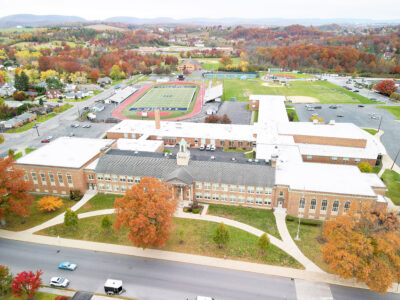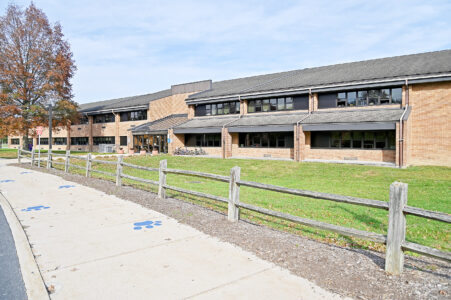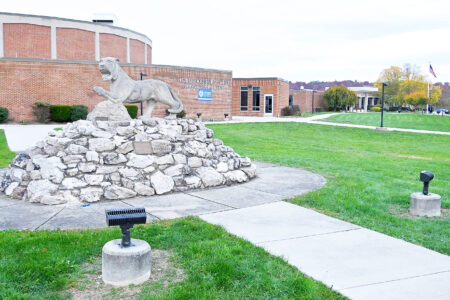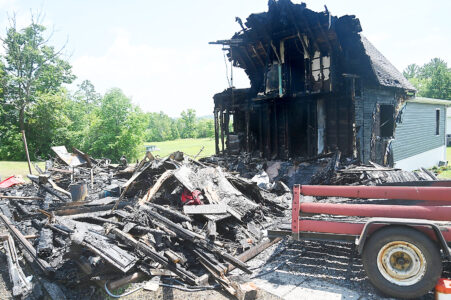Hollidaysburg Area eyes options
Cost to consolidate could top $130 million; enrollment expected to continue to decline
- Hollidaysburg Area Junior High (from foreground to back), Tiger Stadium, C.W. Longer Elementary and Hollidaysburg Area Senior High School are seen from above on Friday. Mirror photo by Patrick Waksmunski
- Charles W. Longer Elementary School is at 1320 Union St., Hollidaysburg. Demolishing Charles W. Longer Elementary to reuse the site for a consolidated elementary school building is the most practical option, according to an update to Hollidaysburg Area’s districtwide feasibility study. Mirror photo by Patrick Waksmunski
- Hollidaysburg Area Senior High School is at 1510 N Montgomery St., Hollidaysburg. Mirror photo by Patrick Waksmunski

Hollidaysburg Area Junior High (from foreground to back), Tiger Stadium, C.W. Longer Elementary and Hollidaysburg Area Senior High School are seen from above on Friday. Mirror photo by Patrick Waksmunski
HOLLIDAYSBURG — The Hollidaysburg Area School District could pay up to $130 million in total construction costs and debt service to complete a sweeping building consolidation plan outlined during a Physical Plant Committee meeting last month.
The plan, which was presented by representatives from Crabtree, Rohrbaugh & Associates, is an update to a districtwide feasibility study initially conducted in 2022 regarding strategies to address ongoing budgetary shortfalls.
Per the CRA recommended roadmap for the district’s future, HASD would follow a four-step plan over the next 12 years.
The first step would be to move ninth grade from the junior high to a newly constructed addition in the senior high building, then move sixth grade into the junior high, followed by some degree of elementary school consolidation and finally a suite of necessary renovations to the Junior High building.
The district campus will most likely require additional work to accommodate increased traffic and parking demand, according to CRA.
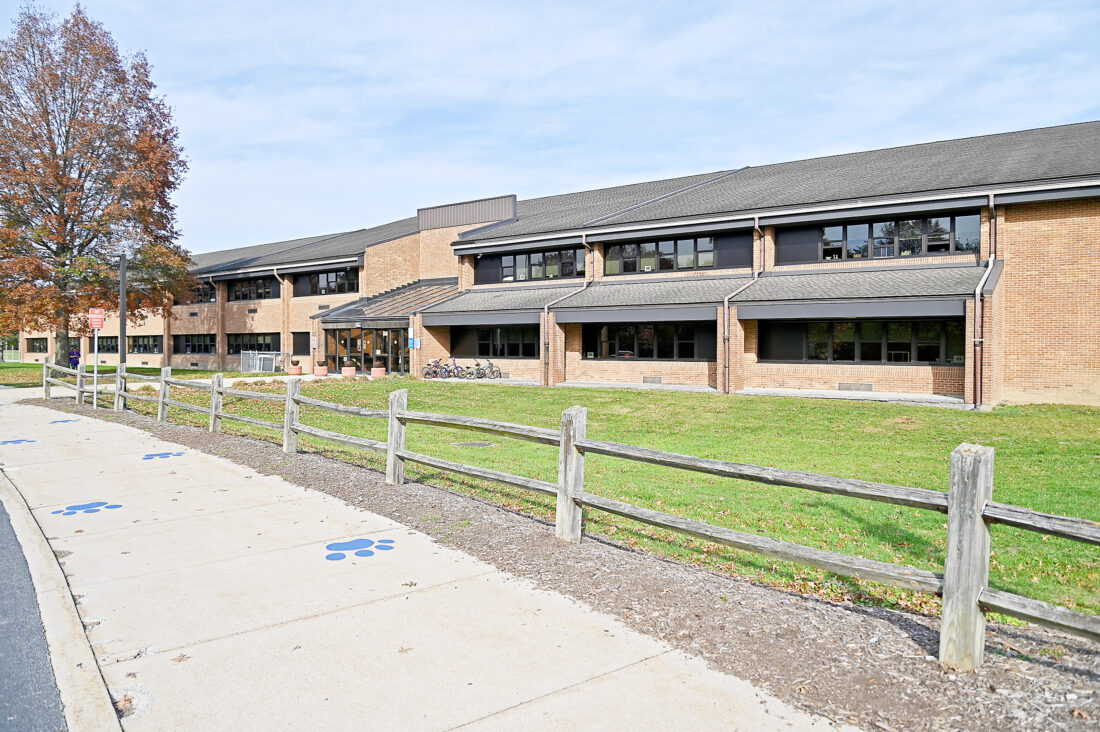
Charles W. Longer Elementary School is at 1320 Union St., Hollidaysburg. Demolishing Charles W. Longer Elementary to reuse the site for a consolidated elementary school building is the most practical option, according to an update to Hollidaysburg Area’s districtwide feasibility study. Mirror photo by Patrick Waksmunski
This masterplan could cost the district between $124.9 million and $129.9 million, depending on what path the project follows, according to an analysis by PFM Financial Advisors.
PFM’s estimate was based on current labor and material costs, and is adjusted for 2024 inflation, PFM senior managing consultant Melissa Hughes said, so the actual number is likely to increase over the length of the project.
Plan details
According to CRA representative Scott Cousin, “the impetus (for the updated master plan) was how can we consolidate our elementary schools and realize some cost savings for the district.”
A key vector for these savings is improvements in building operational efficiency and staffing requirements.
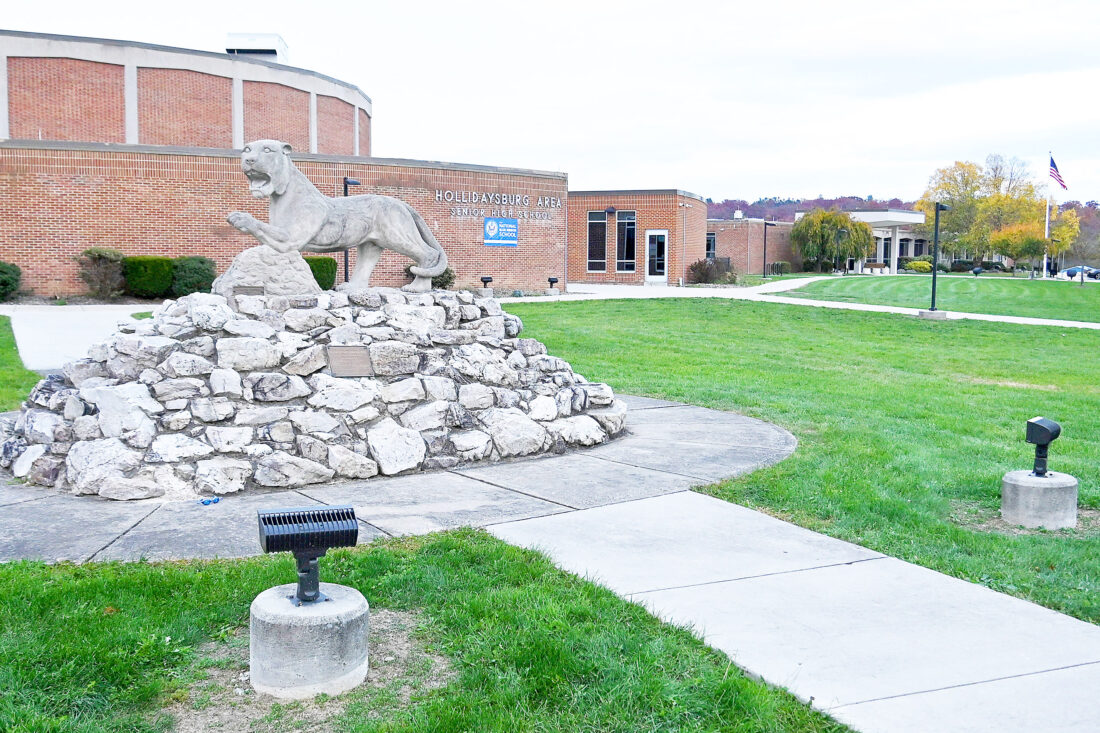
Hollidaysburg Area Senior High School is at 1510 N Montgomery St., Hollidaysburg. Mirror photo by Patrick Waksmunski
According to CRA, over the past 15 years, HASD has seen a downward trend in student enrollment, which decreased sharply during the pandemic, when about 140-150 students left the district.
These students have, largely, not returned after the pandemic, according to CRA director of educational planning Fred Withum.
A “multi-year investigation” into district enrollment that included several projections created by the Pennsylvania Department of Education indicate that HASD’s student numbers will continue to decline through the next nine years, Withum said.
The department of education standard is that school districts should have 10% more seats than enrolled students at the elementary level and 15% more seats than enrolled students at the secondary level, Withum said.
Meaning that a hypothetical high school with 100 students should have the structural and organizational capacity to hold 115 students. This excess is intentionally maintained to prevent “scheduling inefficiencies” related to class size, Withum said.
Hollidaysburg Area will have about 675 empty seats at the elementary level, 335 empty seats at the junior high level and 240 empty seats at the senior high level past the 10% and 15% target by the 2028-29 school year, according to CRA estimates.
CRA enrollment projections are typically within 2% of actual enrollment based on previous public school clients, Withum said.
Senior High addition considered
Moving ninth grade to the senior high would free up space at the junior high to accommodate the moved-up sixth grade, Cousin said, but the senior high would require an addition to fully house the influx of students.
This would constitute a two-story addition with five classrooms, three science labs and smaller areas for special education and other uses attached to the northwest side of the senior high building between the auditorium and baseball field.
According to Cousin, the current master plan is a “5,000-foot level looking down” view, so details such as the exact numbers of classrooms are subject to adjustment as the project proceeds.
The senior high addition will cost between $10.1 million and $11.6 million, not including any additional renovation on the building, Cousin said.
The two primary options for elementary consolidation are closing C.W. Longer, Foot of Ten and Frankstown elementaries while building a new facility where Longer currently stands, or closing two of the three schools, renovating the third and constructing a smaller consolidated elementary.
Substantially renovating Foot of Ten and adding a smaller building to house Longer and Frankstown students would cost about 7% more than consolidating all three into a new building, according to CRA data.
CRA had initially considered a third option of moving the students from all three elementary schools into the junior high building, closing the elementaries and constructing a new junior high on the district campus, but this option was beyond the scope of HASD’s financial means, Cousin said.
One example CRA gave for the design of the new consolidated building would be a two-story structure with three wings of classrooms built off a central “main street” hallway that would hold district administration, cafeteria and other student services like the gym and library.
Demolishing Longer ‘most practical’
Demolishing Longer to reuse the site for the consolidated building is the most practical option, Cousin said, since much of the currently unoccupied area on the campus holds wetlands and is bisected by power lines.
“(The wetlands) you can touch and you can move, but it’s extremely expensive and extremely cost-prohibitive when you do it with a project of this size,” he said.
Students from Longer would be temporarily absorbed by Foot of Ten and Frankstown during the construction process for the new building.
“It would be tight, but it’s the lesser of two evils when you’re dealing with construction on campus,” Cousin said.
This stage of the project would include expanding the current parking lot to the southeast of Longer, extending Union Street north toward the Senior High and adding an access road from the new end of Union Street to North Montgomery Street to improve traffic circulation on campus.
Since the consolidated building would have a larger footprint than Longer, some of the current sports fields would be relocated to accommodate the new construction.
This stage of the master plan would cost between $82.9 and $91.2 million, including the new traffic access and athletic fields.
According to Cousin, $3.8 million of that cost could be eliminated by choosing to not move the district administrative office into the consolidated building.
This consolidation plan would create approximately $1.6 million in annual savings in reduced maintenance, staffing, transportation and utility costs, according to CRA projections.
Staff levels would be reduced over time through attrition not layoffs under this plan.
Renovating Frankstown
Closing two of the elementary schools into a renovated Frankstown and a consolidated building would cost between $84.4 and $93.7 million, with a $3 million deductible due to the district administrative office being similar to the first option.
This second option would save an estimated $797,884 per year, according to CRA data.
Savings for both plans would not be realized immediately, since staff attrition would occur over several years.
If the district decides not to consolidate and opts to maintain all three current elementaries, it will face approximately $41.2 to $47.5 million in upkeep costs within the next 8-10 years, according to CRA data.
HASD is already facing several multi-million renovation projects, such as an extensive senior high roof repair and new junior high boiler, in the same time frame.
The final phase of the master plan would be a number of major projects on the junior high building, including air conditioner replacement, masonry work, roof repairs and upgraded electrical wiring, which would cost between $22.4 and $25.8 million, depending on project scope.
According to the proposed timeline laid out in the master plan, construction for the senior high addition would begin in early 2027, ending in 2028.
The elementary school consolidation work would run 2030 through mid 2032, and the junior high renovation would last from early 2034 till 2036.
Planning and design stages for all options would start at least a year before construction.
Financing options proposed
Hughes addressed the committee after the conclusion of the CRA presentation, briefing them on different ways the district could afford the proposed project.
According to Hughes, the district can currently borrow up to $105 million under state law constraints, which would increase to $127 million by 2031 assuming a 1% annual revenue growth scenario.
These limits are based on the previous three years of school district revenue and principal balance.
“When we’re looking at really long-term analysis like this, we are going to be conservative in our interest rate assumptions, because we’re looking at averages over a long period of time,” Hughes said.
This means that, if the district financed the entire plan today, “everything would look better than what I am going to illustrate,” she said.
PFM’s projection of a $129.9 million total project cost for the three-to-one consolidation option is based on the high end of the ranges according to the work outlined in the CRA master plan. This only accounts for building costs, Hughes said, and does not include any work outside the scope of the plan, such as upgrades to Tiger Stadium or a roof-top solar array installation on the senior high building, which the district may choose to do during the length of the master plan project.
“(HASD) probably has enough capacity to do the things (CRA) presented, but in the constraints of everything we might consider, you might have to make some choices around magnitude or timing,” Hughes said.
According to Hughes, HASD currently has a “lovely debt portfolio” of three series of bonds issued by the district in 2017, 2020 and 2021.
This gives the district a degree of flexibility regarding its financial future.
“If you did nothing, your current debt service would drop off in 2029, and would totally pay off in 2030,” she said.
HASD is obligated to pay $17.5 million in total over the next five years under the current debt payment structure.
One of the borrowing plans offered by PFM would have the district taking out a series of separate loans for each step of the master plan process.
School administrators would be able to look at and evaluate each individual loan over the course of the project, Hughes said.
‘Lot of discipline’ needed on budget
The net amount of all debt repayment for the master plan project would cost the district $219.9 million, paid till 2058, with the senior high and consolidated elementary phases creating around $41.4 million in savings over that period, according to PFM projections.
Depending on the scope of the junior high renovations, the net local effort could grow to $261.3 million in total debt service till 2058.
“It would take a lot of discipline to identify dollars in your budget to accommodate that,” Hughes said.
According to Hughes, it would take district commitment to millage tax increases over the next several years to afford this effort.
“It’s both a pro and a con to this being over a very long timeline,” Hughes said, “the big pro being is it lets (the district) to bite it off in little pieces, with the con being it requires the board, over a long period of time, to have a lot of discipline.”
This discipline is especially important because the required growth in district borrowing capacity is contingent on a sound state of affairs in school finances over multiple years.
“No matter what scenario or direction you go with your facilities, step one is making sure your house is in good order on the operating side,” Hughes said.
HASD currently has an approximate $2.5 million budget deficit.
According to a PDE spokesperson, while HASD received some state reimbursement for previous building renovation projects under the PlanCon program, the program is no longer accepting new applicants and would not reimburse any costs related to the master plan project.
Hollidaysburg Area Superintendent Curtis Whitesel told the Mirror that it will be between six to 12 months before any action is taken on the master plan, and that district administrators will encourage community input on the proposal prior to any vote on adoption.
Mirror Staff Writer Conner Goetz is at 814-946-7535.

